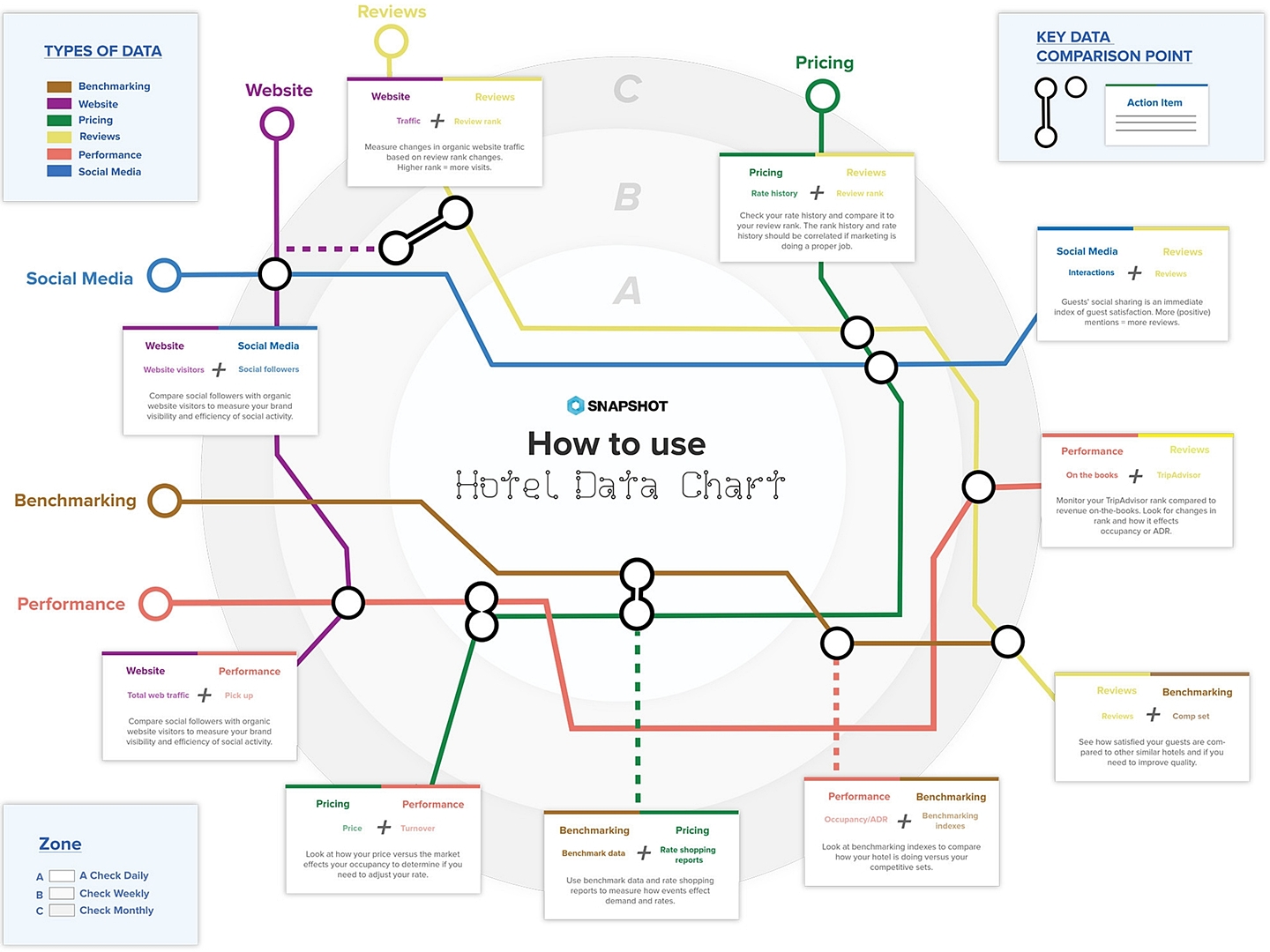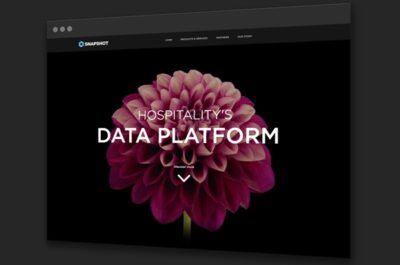SnapShot created a chart of how hotels can use their data.
We're in the information age. There's no doubt about it. Yet, with all this data supposedly flying around us, it's hard to know just what to do with it. Even if your PMS is collecting all the right stats, you're on top of your web traffic and social media interactions, and you know what your comp set is up to, it can be hard to understand how to actually read the data. What does it mean? And more importantly how can you use it to make better decisions?
SnapShot thinks hotel data shouldn't be so complicated. And we want to give you, the hotelier, practical action items you can start using now. We began this project with an idea: That if hoteliers just compared a couple different types of data, they might learn a lot more than when only looking at one type of data. After all, cross examining a data set with another is one of the best and most tried-and-true methods for uncovering new insights into your hotel business and your customers.
We took this "hotel data comparison" idea and visualized it in the form of a subway map where each train line is a category of data that hoteliers encounter every day: PMS or performance data, pricing and benchmarking data, social media, and website data. Where the different lines intersect is a "station" where you can find real-world examples of data comparisons that you can put into practice with your team. After consulting experts in various fields, and refining and revising our list, we ended up with this: The How To Use Hotel Data Chart. No need to hire a quant team or employ some magical algorhythmic solution. These are practical steps that you and your team can take today to start making your hotel data work for you. Trust us, it'll be worth it.
 Website + Social Media
Website + Social Media
To see how effective your social media presence is for your hotel, compare the change in number of followers with the change on your hotel's organic website traffic. While they may or may not immediately convert into reservations, followers should influence the number of visitors on your website. Non-paid website visits is one of your best barometers of brand awareness and will effect your direct and indirect revenue in the long term.
Action Item: Website visitors + Social followers
Compare social followers with organic website visitors to measure your brand visibility and efficiency of social activity.
 Website + Performance
Website + Performance
The total traffic on your website should be reflected in the reservations picked up. Since people on your website may reserve for future dates you won't notice this on your monthly revenue. Instead, it will mostly be seen in the pick up. In this case you want to look at the total traffic, not just organic, since your paid campaigns should be generating new reservations, too. In short: Measure the pick up versus global traffic to see how the campaigns are generating revenue.
Action Item: Total web traffic + Pick up
Measure total traffic to your website against pick up to see if your campaigns are influencing global reservations.
 Pricing + Performance
Pricing + Performance
You are probably already familiar with this example, as most hotels already gauge their rate based on occupancy on a weekly if not daily basis. Understanding how your price, the current market's price, and your occupancy are connected is the most common use of data in hospitality today, but it shouldn't be forgotten since it is one of the most efficient ways to determine overall revenue.
Action Item: Price + Turnover
Look at how your price versus the market effects your occupancy to determine if you need to adjust your rate.
 Performance + Benchmarking
Performance + Benchmarking
While the science behind figuring out your competitive set is important, the fact remains that comparing how your hotel is doing versus the market is equally important to ensure that your hotel is either leading or following the market. It also helps to understand if your hotel needs to change something on the marketing side or if there is a generalized condition across the market.
Action Item: Occupancy/ ADR + Benchmarking indexes
Look at benchmarking indexes to compare how your hotel is doing versus your competitive sets.
 Reviews + Benchmarking
Reviews + Benchmarking
Guest satisfaction in your hotel compared to other hotels (as is measurable through Reputation Management Tools or TripAdvisor) will give you an index of how you are doing in terms of the quality of experience for guests. This can help you see if there are specific parts of your hotel's experience that need improving (breakfast, mattresses, et cetera). This will also give you insights into how you can raise your average daily rate if you notice areas that are better than your competitors.
Action Item: Reviews + Comp set
See how satisfied your guests are compared to other similar hotels and if you need to improve quality.
 Performance + Reviews
Performance + Reviews
Number of reviews compared to the revenue on the books can show you how reviews alone drive revenue. A telling example is in comparing TripAdvisor Rank and pick up: As your rank increases you can see accurately how that effects your reservations on the books. As the rank lowers you may experience cancellations however as the rank goes up you may see the hotel picking up reservations, allowing you to adjust rates accordingly.
Action Item: On the books + TripAdvisor
Monitor your TripAdvisor rank compared to revenue on-the-books. Look for movement in rank and how it effects occupancy or ADR.
 Pricing + Reviews
Pricing + Reviews
There should be a direct correlation between the review rank you had last month or year against the rate you had last month or year. While it's also influenced by general market demands, your selling power will nevertheless be effected by reported guest satisfaction and word-of-mouth as reflected in your review rank.
Action Item: Rate history + Review rank
Check your rate history and compare it to your review rank. The rank history and rate history should be correlated if marketing is doing a proper job.
 Social Media + Reviews
Social Media + Reviews
As your hotel experiences more mentions in social shares (as long as they are positive) you should see more positive reviews. If not, this is a great time to interact with guests and incite them to leave a review on their favorite review sites. Social interaction will be faster and more "raw" so this is also a great place to catch negative reviews before they escalate to official review sites.
Action Item: Interactions + Reviews
Guests' social sharing is an immediate index of guest satisfaction. More (positive) mentions = more reviews.
 Benchmarking + Pricing
Benchmarking + Pricing
The average rate index from benchmarking and rate shopping data can show you the rates that are being advertised on your market versus the rates that actually sell. By measuring the changes in the benchmarking index and the changes for future dates you can limit the last minute rate drops or “surprises.”
Action Item: Benchmark data + Rate shopping reports
Benchmark data and rate shopping reports can show the effect on market demand certain events are having on the hotel rate.
 Website + Reviews
Website + Reviews
When searching for a hotel, the second most searched for keyword is the name of the hotel followed by "reviews." While guests will visit the website and then go check out reviews, they will also check out reviews and then visit the website. The higher the hotel is in review ranking the more new customers the hotel gets. And the change in visits to the website will be faster than the change in on-the-books revenue.
Action Item: Traffic + Review Rank
Measure changes in organic website traffic based on review rank changes. Higher rank = more visits.
Conclusion
The Action Items above are just some of the most common and beneficial correlations between hotel data. But there are plenty more examples out there. Our objective with this article and chart is to show how valuable your hotel data can be when used in creative ways. The data alone won't do much for you, but used wisely, can be immensely powerful. When you use an analytics tool like SnapShot Analytics, it makes it easy to put your hotel's data in perspective, and improve everyday management decisions.
So use the examples above, they're a great start, but there's so much more out there!
Click here to get the full, hi-res How To Use Hotel Data Chart.






























































































































































































































